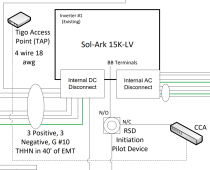Dustoff
New Member
Did you figure anything out on running blind?I am heading the DIY route and ditching my SolarEdge optimizers so I can run an EG4 inverter. I do have shading and panels on different roof pitches, so I do think I need at least some optimization.
Did you have any issues running the TS4-A-O's "blind" as stand-alone optimizers? Did you notice huge improvements after getting them properly installed with the CCA/TAP?
They make it sound scary on the TIGO website: https://support.tigoenergy.com/hc/en-us/articles/4770355167635-TS4-Systems-Blind-Deployment
Any info you have will be greatly appreciated! I never saw your official verdict after getting things properly configured.
I’m debating running Two strings of seven, East to mppt 1
Two strings of seven, west to mppt 2
And one string of six on the East roof, with one string of six on the West roof to mppt 3
I need RSD, but I’m not sure I want to deal with the communications and would consider “blind”.
The reason for this layout is to avoid having to ground mount the third mppt…i can fit 20 panels on each side of the roof. In this configuration, I can run a west string and an East string on the third mppt with 12 panels. It would not be quite as beneficial as the mppt being filled with two south facing strings of seven…but it would save a lot of headaches being able to have all panels roof mounted.
I already have the Tigo Ts4 A-F RSD for all panels…I’d just be swapping to the Tigo TS4 A-O for the 12 that would be split between East-west
Northern Wind & Sun suggested microinverters & ac coupling, but I’m looking to avoid ac coupling, to leave it easier for generator install. (100% off grid single Sol-ark 15k, which will be paralleled down the line)
Others have pointed out the issue with petty local criminals & outside mounted RSD…but I’d add that I also don’t want my system to be able to be remotely shut down. So, I’ll be exploring ways to limit this as well.
It may seem tinfoily to many, but I’ve had my identity stolen (via Sim-swap). It really makes one think about all the available ways bad actors can exploit you.
This seems like such a simple problem to solve, especially on a 3:12 (15 degree) roof, but East-West configuration brings challenges I didn’t initially plan for.
Also, regarding Tigo TS4 A-F versus Tigo A-O, someone mentioned they are different technologies? Does that mean I could not use the A-F with the A-O on the same central RSD?




